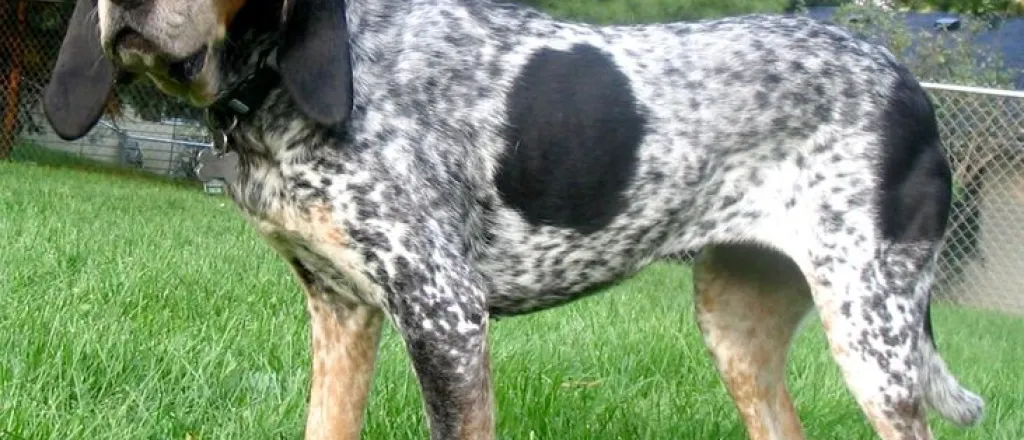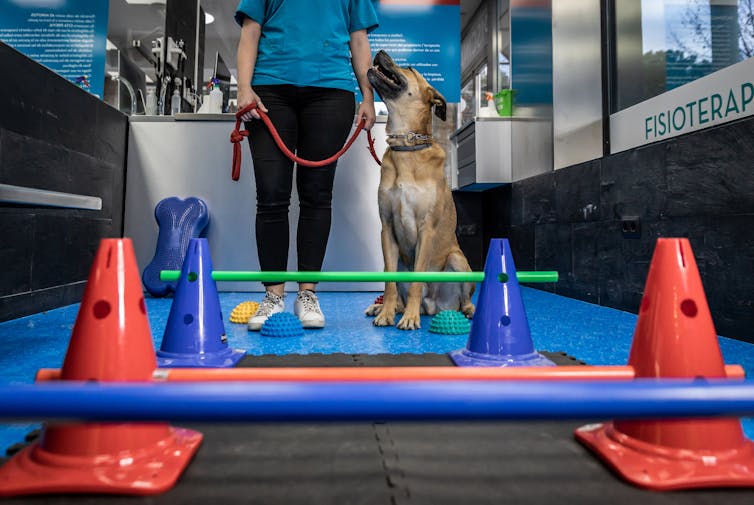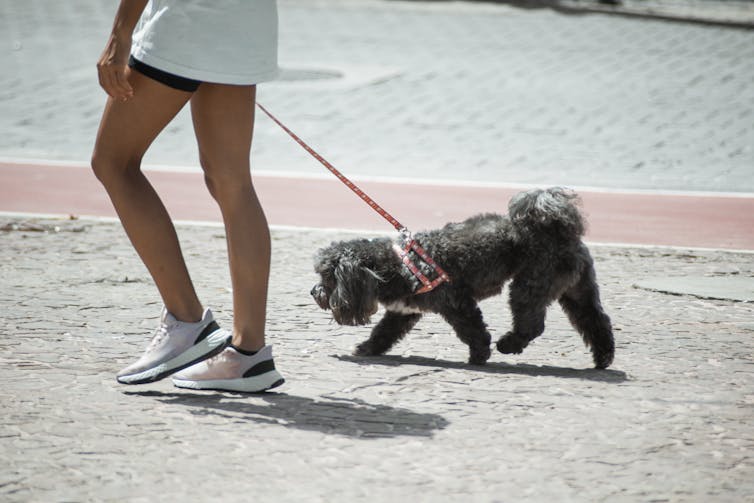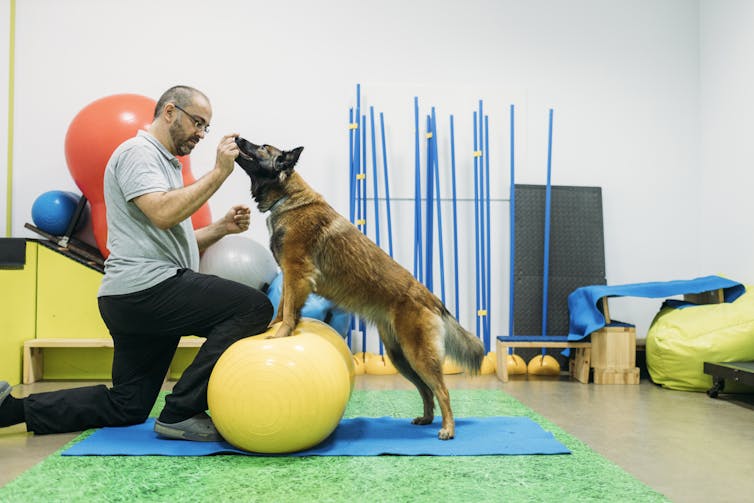
For dogs with arthritis, daily activities don’t have to be painful

Michael Jaffe, Mississippi State University and Tracy Jaffe, Mississippi State University
Otis was our bighearted bloodhound, whom we loved dearly. He had an active life playing with our three other dogs and going for long walks every morning and evening with us. But when he was 8 years old, his lifestyle completely changed. He experienced a knee injury that required surgery, and he later developed osteoarthritis from that injury.
As faculty members at the Mississippi State University College of Veterinary Medicine, we see approximately 100 dogs and cats in our hospital daily. Our job is to diagnose and treat medical conditions these animals are experiencing, and when necessary, perform surgery on patients whose condition is severe.
Like Otis, many of our patients suffer from canine osteoarthritis – the most common orthopedic disorder that we see in our clinic. More than 20% of dogs over the age of 1 in North America are thought to be affected by osteoarthritis. Common activities like going for long walks, running and playing often become more difficult for dogs with this condition.
How can you tell if your dog has arthritis?
Common signs of canine osteoarthritis include stiffness after rest, difficulty getting up, limping or avoiding the use of one leg. Arthritic dogs may also be less active, or reluctant to use stairs or get in or out of a vehicle. For pets with arthritis, just going for a walk or playing in the yard can result in joint pain and muscle soreness.

As in people, arthritis is a degenerative process defined as inflammation of a joint. It can occur in both young and old dogs, though it is more common as dogs age. Sometimes, as in Otis’ case, arthritis develops following an injury. It can impact all components of the joint, but the cartilage – the connective tissue covering the bones where a joint is formed – is the most affected.
Unfortunately, canine arthritis cannot be cured. Instead, the goal of treatment of arthritis in dogs is to reduce inflammation and increase comfort to improve a dog’s quality of life regardless of age.
What causes arthritis in pets?
Arthritis develops in pets because of age-related changes in the joint similar to that which occurs in people. Pets that are very active may be prone to mild injuries that can later develop into arthritic joints as they get older.
Other pets may be born with a hereditary problem that develops into arthritis as they age. Some breeds, including German shepherds, golden retrievers and Rottweilers, may be more prone to developing arthritis as a result of a condition like hip dysplasia, which causes loose hip joints.
When arthritis is suspected, a veterinarian can confirm it, often through X-rays of the affected joint. Once the condition is diagnosed, a veterinarian will then come up with a treatment plan for each patient.
Veterinarians generally prefer nonsurgical treatment. Although surgical options exist, including joint replacement, most dogs can be successfully managed through a combination of approaches including weight management, exercise, joint supplements, prescription anti-inflammatory medications – or NSAIDs – and physical therapy.
Here’s how each of these works to help arthritic dogs stay healthy and active.
Weight management
Weight management is an essential aspect of managing arthritis in pets. When a pet is less physically active, it may lose some muscle mass and gain weight in the form of body fat. Coupled with arthritis, this reduction in muscle tone and added weight places additional pressure on already achy joints.
Cutting back on a few treats and carefully monitoring calorie intake will go a long way in helping your dog shed a few pounds and reduce its discomfort. As in people, weight loss doesn’t happen overnight. Ask for guidance from your veterinarian.
Exercise
Exercise is another important aspect of maintaining healthy joints and keeping weight controlled. Low-impact exercises such as leash walks, swimming and light running are valuable as long as your dog does not overdo it.
How will you know how much movement is too much? In general, walks and jogs should be of a distance, time or intensity such that your dog comes home from that activity still feeling comfortable. That means that if your four-legged companion leads you at the beginning of your walk, it should still be able to stay ahead of you at the walk’s end.
If your pet trudges behind you as you are nearing home, it may be because it is starting to feel tired and its joints are hurting. The signals dogs send their humans are important to monitor so that owners know when to cut back on the length or intensity of a walk or run.

It is possible to overdo the activity of an arthritic pet and cause discomfort. Just as we might not want to go right back to the gym the day after a hard workout, a pet may not be ready to exercise right away either. Rest is the best remedy for sore muscles. A good day or two of rest, sometimes even longer for an arthritic pet, may be necessary between intense periods of exercise. The key to knowing if your pet is ready to go again is if it can rise from a resting position easily and doesn’t appear slow or sore.
Joint supplements
Just as in people, joint supplements are available for pets with arthritis. These products, such as glucosamine and chondroitin sulfate, provide nutrients and building blocks for healthy joint function. Essential fatty acids, like those found in fish oils for dogs, can also help prevent some inflammation in arthritic pets. Some owners give up on joint supplements because they do not see dramatic improvement in their pets right away. However, these products work internally, just like the multivitamins people take, and their benefits may be gradual and subtle.
Other treatments such as polysulfated glycosaminoglycan injections, also known as Adequan, may be used to prevent further worsening of osteoarthritis early in the course of the disease.
NSAIDs
Anti-inflammatory drugs may be prescribed by a veterinarian when a dog has significant joint pain from chronic inflammation. These medications effectively reduce discomfort but may have negative side effects, such as kidney or liver damage, that may limit long-term use. However, they can effectively keep a patient comfortable as long as a veterinarian carefully monitors their use.

Rehab or physical therapy
Canine rehabilitation and physical therapy specialists work with dogs that are arthritic or out of condition to improve limb function, rebuild muscle and assist in weight management. Specific exercises for arthritic pets, such as little jumps known as “cavalettis,” may be tailored to enhance limb movement while providing comfort. Helping an arthritic dog’s ability to move around better will allow it to exercise more and improve its muscle tone while assisting in weight loss.
Healthy joints, happy pets
Helping older or arthritic pets keep their joints healthy and their bodies in good condition can let them enjoy walks and playtime throughout the duration of their lives. Even pets with advanced arthritis can maintain a good quality of life and stay active with the help of a veterinarian and good treatment plan.
[Over 150,000 readers rely on The Conversation’s newsletters to understand the world. Sign up today.]
Sadly, we lost Otis a few years ago at the age of 11. But for the three years following his surgery, we were able to manage his arthritis and maintain his comfort with a combination of weight management, exercise, NSAIDs, essential fatty acids and joint supplements. He was able to get back to the activities he loved and play with our other three dogs. It warmed our hearts to see his quality of life return to a happy, healthy one for his remaining years.![]()
Michael Jaffe, Associate Professor of Small Animal Surgery, Mississippi State University and Tracy Jaffe, Clinical Instructor of Veterinary Medicine, Mississippi State University
This article is republished from The Conversation under a Creative Commons license. Read the original article.

















